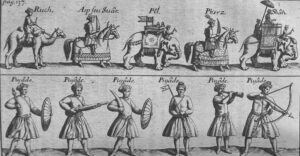 By Emma Laws, Cathedral Librarian
By Emma Laws, Cathedral Librarian
This engraved plate is from the Cathedral Library’s first-edition copy of De Ludis Orientalibus Libri Duo, a history of Eastern games compiled by Thomas Hyde (1636-1703) and published at the Sheldonian Theatre in Oxford in 1694. Hyde was an accomplished linguist, proficient in Arabic, Chinese, Hebrew, Persian, Malay, and Turkish, and a former Librarian at the Bodleian Library in Oxford. As it turns out, he wasn’t a chess player**, but he wrote an early history of the game as it originated in India in the 7th century and spread west to Persia and the Arab world, and then to Europe via Spain and Italy.
If you are a chess player, you will likely have already noted that the chess pieces in this engraving are rather different to the ones you play with at home. These are from Shatranj, an ancient Middle Eastern form of chess that evolved from the original Indian game called Chaturanga. The changing form and function of chess pieces demonstrates how the game spread throughout the world, transforming and adapting to different cultures at different times:
- Ruch: on the top left of the engraving is the ruch (rukh in Indian and Persian traditions), meaning ‘chariot’. In the Middle Eastern tradition, the rukh was often depicted as a camel because camels were important vehicles of transportation and symbolised strength and mobility. When chess reached Europe, the piece transformed to a castle or fortress capable of a strong, straight attack.
- Asp: the Persian Asp (faras in Arabic), meaning ‘horse’, is a cavalry knight; the piece doesn’t charge directly at the enemy but makes a tactical and agile L-shaped leap over other pieces. Rather confusingly, the knight moves hippogonally, like a horse – nothing to do with hippos!
- Pil: the Pil (fil in Indian and Arabic) was an elephant in early chess games, symbolising power and strength; it could move just two squares diagonally in any direction. In Europe, the elephant gradually transformed into a bishop with the improved ability to move any number of squares diagonally.
- Pherz: the Pherz (wazir in Indian; and farzin in Persian), meaning ‘vizier’, ‘counsellor’ or ‘advisor’ to the king, was able to move just one square diagonally in any direction. In 15th century Europe, this piece transformed into the queen, the most powerful and versatile piece with almost unlimited movement diagonally or straight, forwards or backwards.
- Shah: the Shah, or king, is all-powerful but vulnerable and in need of protection. The king’s movement is very limited and he is dependent on the military strength and manoeuvrability of his cavalry and infantry. In this engraving, the shah rides an elephant, not to be confused with the Pil (described above). Did you know? The term ‘check-mate’ comes from the Persian phrase ‘shah-mat’, meaning ‘the king is dead’.
- Piyade: the bottom row of figures in the engraving depicts several Piyade, or pawns; these front-line infantrymen are a collective presence but can be individually sacrificed as part of a military strategy. Eventually, pawns could be promoted to any chess piece if they fought well and overcame challenges to reach the far side of the board – perhaps reflecting growing ideas of social mobility within late medieval society.
** The Librarian of Exeter Cathedral is also not a regular chess player!